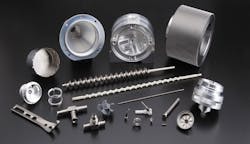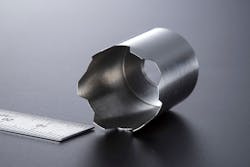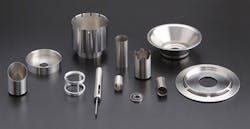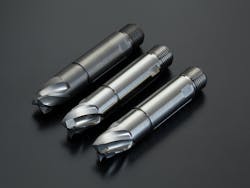Advanced Machining for Hard-to-Make Parts
Advanced machining can solve many of the challenges of today’s increasingly difficult-to-produce parts such as miniaturization, part complexity, strict tolerances, thin walls, material hardness and smoothing rough surfaces. Here are five examples of typical manufacturing hurdles engineers face and how advanced machining can overcome them.
Strict Tolerances
On a part with a tight hole entrance tolerance, the tool length, tool angle, and thermal fluctuations during manufacturing can make it difficult to maintain that tolerance. Advanced microfabrication and high-speed rotary forming can create a miniature part to exact specifications, and the right tools and jigs will hold parts in place for a smooth surface finish.
Advanced machining tools, such as end mills with minimum diameters down to 0.01 mm, can efficiently and consistently perform milling, hole drilling and S0.5 (0.5-mm diameter) thread cutting—even for hole entrance tolerances of ±5 µm or less. These tools can also meet a thickness tolerance of 0.15 ± 0.01 millimeters and maintain a surface roughness profile of Ra 0.1 µm. These specifications are often too difficult for many manufacturers.
Thin Walls
A conventional press may seem a good way to make miniature steel parts with thin walls, but it can generate heat and create residual material stresses. These make it difficult to make precise wall thicknesses without distorting the material and adding time and expense to the job. Despite these drawbacks you can still use a conventional press, but machining them offers precision and cost advantages.
Consider a round, cylindrical part like a stainless-steel motor housing. Such parts often call for wall thicknesses as small as 0.2 ± 0.05 mm. This specification is well within the capabilities of advanced machining, which can make walls as thin as 0.035 mm while maintaining precise geometric tolerances for roundness and concentricity.
Complex Shapes and Surface Roughness
Demanding applications often call for stainless steel parts with both complex shapes and surface roughness challenges. Part with contoured surfaces in multiple axes need the latest machining technology. Stainless steel valves for fuel cell vehicles, for instance, must have scratch- and burr-free internal passages. This is an ideal task for advanced machining’s precision and quality finishes.
For example, advanced machining can create intricate parts with outside diameters smaller than Ø160 to strict geometric tolerances. It can also provide concentric groove machining and four-axis grinding, plus a range of surface finishes such as seal-surface and mirror-surface finishes.
Titanium and Superalloys
For many part makers, machining titanium and superalloys such as Hastelloy poses problems. They are among the most difficult-to-cut materials, but are often used in critical applications where equipment manufacturers demand uncompromising accuracy and quality.
To process titanium or other hard-to-cut materials, companies should partner with a specialist that uses high-performance machine tools and understands machine tool technology and metallurgy. They will be aware of the latest chucking and cooling technologies, cutting speeds and cutting tools, and can assemble several parts and process them to get the specified surface roughness. Some, like Aomi Precision, have built databases of various processing requirements and conditions for hard-to-cut materials. This lets them quickly offer and then deliver the most suitable machining methods for parts.
If faced with a demanding part design, it can be easy to reflexively fall back on tried-and-true production methods. Satisfaction with conventional methods in the past can leave designers on the fence about whether to move onto advanced machining. And designers who only need a small batch of parts or just a prototype or two might think advanced machining is beyond the budget. But for many small, more-intricate and difficult-to-manufacture parts and prototypes, this could be a prime time for exploring and taking advantage of the capabilities and quick turnarounds of advanced machining.
Advanced machining can be a more attractive option than conventional production methods given that specialized machining companies have the technology, experience, and metallurgical knowledge to tackle many hard-to-make parts to exacting specifications. They also keep costs in check by making special tools in-house and eliminating costly third parties, so parts go from prototype to production and delivery faster.
Tsuyoshi Aomi is the chairman and CEO of Aomi Precision.





